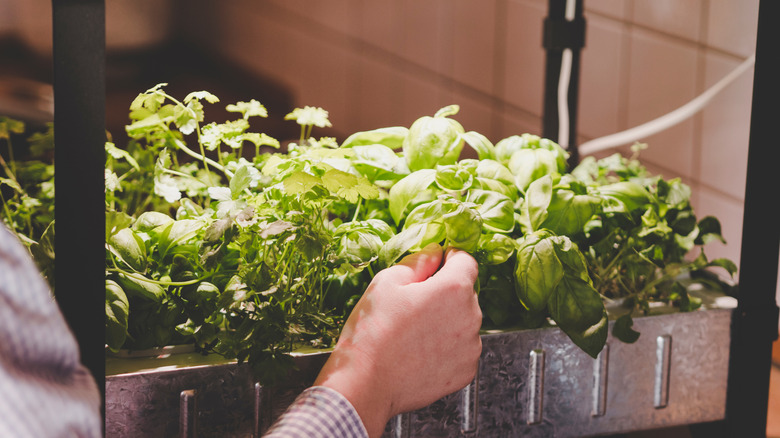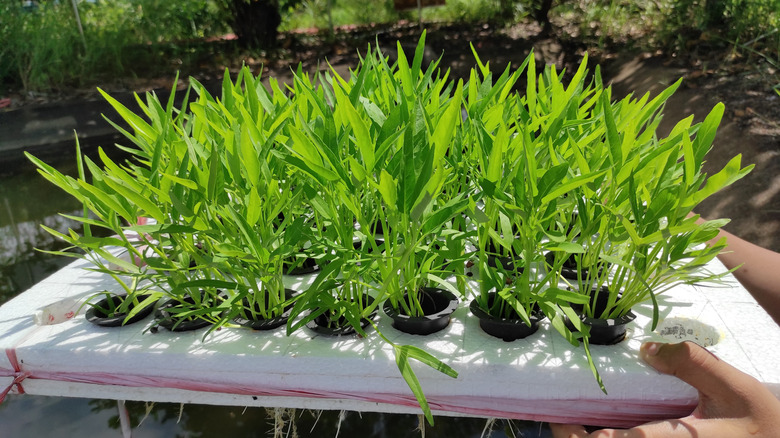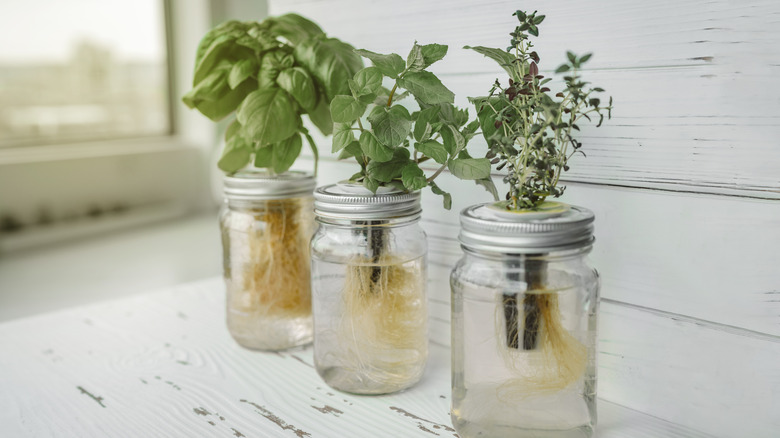A Hydroponic Garden Lets You Grow Produce From Your Own Apartment
There's nothing better than growing your own produce. It's fresh, sustainable, pesticide-free, budget-friendly, and always within reach. The challenge, of course, is space. Not everyone has access to a garden, especially if you live in the middle of a city. If you've been yearning for the joy of watching the juiciest tomatoes ripen before your eyes, you can do it without needing a dedicated plot of land or even soil. You just need some nutrient-rich water and an inert medium like organic coco coir, clay pebbles, rock wool, or pumice to grow your plants in and support their root structure. Yes, we're talking about hydroponic gardening.
For those not familiar with this technique, hydroponic gardening is a soil-free method that lets you grow crops indoors, though you can use it outdoors too. In fact, the U.S. Army used hydroponic systems during World War II to grow fresh produce for troops. However, this system works especially well for those working with limited space and looking to set up a low-maintenance home garden. Since it relies on controlled conditions, hydroponics can encourage faster, healthier plant growth — right from your living room. You can use hydroponic techniques to grow your kitchen herb garden, and it's especially handy for herbs that are hard to come by at the store or when you need to cook with fresh herbs instead of dried ones.
The best hydroponic methods for beginners
Passive systems are ideal for beginners, as they require minimal effort to get off the ground. Among them, the wick system is considered the simplest: A string or piece of cloth (the wick) connects the plant (placed in a small pot) to a reservoir of nutrient-rich water. The wick gradually draws the water up to the plant's roots, delivering just what it needs, when it needs it — no more, no less. Think of it like a plant sipping through a straw. You can set up a wick system from scratch or buy a pre-made version; There's no shortage of options online.
The Kratky method has been gaining popularity lately. It's a more hands-off, budget-friendly way to dip your toes into hydroponic gardening. All you need to do is place your plant in a container filled with water and nutrients. You can even repurpose mason jars from your kitchen. As the plant grows and drinks, the water level drops, and the roots reach down to meet it. The gap left at the top gives the roots the breathing room they need.
A few variations of the deep water culture method also work well for home growers, though you'll need to pick up an air pump to keep things bubbling along. These pumps won't break the bank. You can easily find one on Amazon for under $20. In this setup, the plant sits in a bucket of nutrient-rich water while the pump delivers a steady stream of bubbles to keep the roots happy and oxygenated.
Beginner-friendly plants to grow with hydroponics
Leafy greens are a great place to start if it's your first time trying hydroponics. You can also gauge your eating habits and plant accordingly to make the system more efficient. So, if you're into sandwiches, maybe start by growing some crisp lettuce at home. Or, if there's an underrated herb you use often for cooking that's not easily available, like chervil, you can grow that, too. Other leafy greens and herbs that thrive in hydroponic setups include spinach, basil, kale, arugula, celery, rosemary, thyme, and mustard greens. When it comes to vegetables, cabbage and carrots are great options. And if you want to bring more hues and variety into your kitchen garden, fruits like tomatoes and strawberries also do well in hydroponic systems.
There are many plants you can grow with this brilliant method right inside your home. Remember that garden in the stunning film "The Taste of Things," in which Juliette Binoche gathers ingredients from her luminous plot to whip up those awe-inspiring dishes? You can bring that feeling indoors. Just be sure to pay attention to lighting. Investing in good-quality LED grow lights is ideal for a more controlled setup, especially if you're planning to keep your garden growing year-round. Make sure they're positioned at the proper height, and you'll be well on your way to creating your own mini version of "The Taste of Things," only instead of an expansive garden in 19th-century France, you'll be growing your veggies in the comfort of your apartment, without the need for soil.


